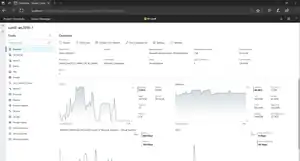Windows Admin Center
Windows Admin Center (codenamed Project Honolulu) was unveiled by Microsoft on September 14, 2017 as the necessary evolution of the Windows Server graphical user interface (GUI). Officially launched in public preview under the code name Project Honolulu at the Microsoft Ignite 2017 conference in Orlando, Florida, Windows Admin Center offers "flexible, locally-deployed, browser-based management platform and tools". The idea behind this project is to help simplify management of servers by placing a majority of the frequently referenced tools used by system administrators in one spot. On April 12, 2018 the project left preview and was named Windows Admin Center.
 Web based graphical interface to manage Windows Server infrastructure offered by Microsoft. | |
| Developer(s) | Microsoft |
|---|---|
| Initial release | April 12, 2018 |
| Stable release | 2009
/ September 22, 2020[1] |
| Operating system | Windows Server 2016 or later, Windows 10 or later |
| Platform | x64 |
| Type | Systems management |
| License | Freeware |
| Website | docs |
Features
A list of features that are offered from this web based administration tool are as follows, and expected to grow with the ability for plugins and 3rd party extensions:
- Overview
- Azure hybrid services
- Azure Backup
- Azure File Sync
- Azure Monitor
- Azure Security Center
- Certificates
- Devices
- Events
- Files
- Firewall
- Installed apps
- Local users & groups
- Network
- PowerShell
- Processes
- Registry
- Remote Desktop
- Roles & features
- Scheduled tasks
- Services
- Storage
- Storage replica
- Updates
- Virtual Machines
- Virtual Switches
- Settings[lower-alpha 1]
There are a few like Storage Replica which don't have any alternative GUI so far.
In addition, Windows Admin Center also offers Hyper Converged Cluster Management.
At present, Microsoft only supports Microsoft Edge and Google Chrome browsers. Internet Explorer and Firefox are not supported.
Server compatibility
This tool is meant to manage Windows Server 2012 and later. Windows Admin Center also supports managing Windows 10 with fewer tools. In order for it to be able to manage Windows Server 2012 or 2012 R2, the Windows Management Framework (WMF) version 5 or higher must be installed.
Client compatibility
When it comes to installing Windows Admin Center, it can be installed on a Windows 10, Windows Server 2016 or later operating systems. Installing Windows Admin Center requires a ~64MB Microsoft Installer Package (MSI). Walking through the installation it will ask for a port to serve the website on, as well as the ability to generate a self-signed SSL cert or use an SSL cert from your Certificate Authority, for example. In terms of configuration options that is all that is required to install. Upon completion, access Windows Admin Center over the web you will need to add servers in order to manage them.[2]
Simplified management
Windows Admin Center was brought into existence because "IT admins have repeatedly told us that PowerShell is necessary but not sufficient, and that Windows Server ease-of-use is still largely dependent on GUI Tools for core scenarios and new capabilities"[3] Windows Admin Center builds off of the Microsoft Management Console (MMC) that was first introduced in Windows 2000. It takes some of the most commonly accessed management utilities, such as the Event Viewer, Roles and Features, Hyper-V management, Windows Firewall, and the Registry editor and combines them into a centrally accessible, web based friendly, intuitive interface that makes accessing these items simplified and straightforward.[4]
Footnotes
- Not to be confused another Settings page that pertains Windows Admin Center itself. This Settings page configures the target computer.
References
- https://techcommunity.microsoft.com/t5/windows-admin-center-blog/windows-admin-center-version-2009-is-now-generally-available/ba-p/1696665
- "Microsoft Honolulu project". Archy.net. 2017-09-28. Retrieved 2017-10-08.
- "Microsoft Brings Back the GUI with 'Project Honolulu' for Windows Server Management -- Redmondmag.com". Redmondmag. Retrieved 2017-10-08.
- "Microsoft unveils Project Honolulu, a new GUI for server administration". Ars Technica. Retrieved 2017-10-08.